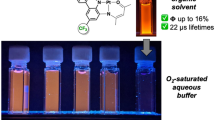Abstract
Diruthenium tetracarbonyl complexes of the type [Ru2(CO)4(μ2-η2-O2CR)2L2] containing a Ru–Ru backbone with four equatorial carbonyl ligands, two carboxylato bridges, and two axial two-electron ligands in a sawhorse-like geometry have been synthesized with porphyrin-derived substituents in the axial ligands [1: R is CH3, L is 5-(4-pyridyl)-10,15,20-triphenyl-21,23H-porphyrin], in the bridging carboxylato ligands [2: RCO2H is 5-(4-carboxyphenyl)-10,15,20-triphenyl-21,23H-porphyrin, L is PPh3; 3: RCO2H is 5-(4-carboxyphenyl)-10,15,20-triphenyl-21,23H-porphyrin, L is 1,3,5-triaza-7-phosphatricyclo[3.3.1.1]decane], or in both positions [4: RCO2H is 5-(4-carboxyphenyl)-10,15,20-triphenyl-21,23H-porphyrin, L is 5-(4-pyridyl)-10,15,20-triphenyl-21,23H-porphyrin]. Compounds 1–3 were assessed on different types of human cancer cells and normal cells. Their uptake by cells was quantified by fluorescence and checked by fluorescence microscopy. These compounds were taken up by human HeLa cervix and A2780 and Ovcar ovarian carcinoma cells but not by normal cells and other cancer cell lines (A549 pulmonary, Me300 melanoma, PC3 and LnCap prostate, KB head and neck, MDAMB231 and MCF7 breast, or HT29 colon cancer cells). The compounds demonstrated no cytotoxicity in the absence of laser irradiation but exhibited good phototoxicities in HeLa and A2780 cells when exposed to laser light at 652 nm, displaying an LD50 between 1.5 and 6.5 J/cm2 in these two cell lines and more than 15 J/cm2 for the others. Thus, these types of porphyric compound present specificity for cancer cell lines of the female reproductive system and not for normal cells; thus being promising new organometallic photosensitizers.






Similar content being viewed by others
References
Brown SB, Brown EA, Walker I (2004) Lancet Oncol 5:497–508
Dolmans DEJGJ, Fukumura D, Jain (2003) Nat Rev Cancer 3:380–387
Nyman ES, Hynninen PH (2004) J Photochem Photobiol B 73:1–28
Qiang YG, Zhang XP, Li J, Huang Z (2006) Chin Med J 119:845–857
Juillerat-Jeanneret L (2006) Trends Cancer Res 2:71–84
Barrrett AJ, Kennedy JC, Jones RA, Nadeau P, Pottier RH (1990) J Photochem Photobiol B 6:309–323
Rosenberg B, van Camp L, Krigas T (1965) Nature 205:698–699
Reedijk J (1996) Chem Commun 801–806
Wong E, Giandomenico CM (1999) Chem Rev 99:2451–2466
Jakupec MA, Galanski M, Keppler BK (2003) Rev Physiol Biochem Pharmacol 146:1–53
Galanski M, Arion VB, Jakupec MA, Keppler BK (2003) Curr Pharm Des 9:2078–2089
Ang WH, Dyson PJ (2006) Eur J Inorg Chem 4003–4018
Melchart M, Sadler PJ (2006) In: Jaouen G (ed) Bioorganometallics. Wiley-VCH, Weinheim
Lottner C, Bart KC, Bernhardt G, Brunner H (2002) J Med Chem 45:2064–2078
Lottner C, Bart KC, Bernhardt G, Brunner H (2002) J Med Chem 45:2079–2089
Kim YS, Song R, Kim DH, Jun MJ, Sohn YS (2003) Bioorg Med Chem 11:1753–1760
Lottner C, Knuechel R, Bernhardt G, Brunner H (2004) Cancer Lett 203:171–180
Lottner C, Knuechel R, Bernhardt G, Brunner H (2004) Cancer Lett 215:167–177
Schmitt F, Govindaswamy P, Süss-Fink G, Ang WH, Dyson PJ, Juillerat-Jeanneret L, Therrien B (2008) J Med Chem 51:1811–1816
Schmitt F, Govindaswamy P, Zava O, Süss-Fink G, Juillerat-Jeanneret L, Therrien B (2009) J Biol Inorg Chem 14:101–109
Crooks GR, Johnson BFG, Lewis J, Williams IG, Gamlen G (1969) J Chem Soc A 2761–2766
Bruce MI, Jensen CM, Jones NL (1989) Inorg Synth 26:259–261
Daigle DJ (1998) Inorg Synth 32:40–45
Poncet S, Meyer S, Richard C, Aubert JD, Juillerat-Jeanneret L (2005) Am J Obstet Gynecol 192:426–432
Vallinayagam R, Schmitt F, Barge J, Wagnières G, Wenger V, Neier R, Juillerat-Jeanneret L (2008) Bioconjug Chem 19:821–839
Gurba P, Vallinayagam R, Schmitt F, Furrer J, Juillerat-Jeanneret L, Neier R (2008) Synthesis 24:3957–3962
Schneider R, Schmitt F, Frochot C, Fort Y, Lourette N, Guillemin F, Muller JF, Barberi-Heyob M (2005) Bioorg Med Chem 13:2799–2808
Johnson BFG, Johnston RD, Lewis J, Williams IG (1971) J Chem Soc A 689–691
Micoli F, Salvi L, Salvini A, Frediani P, Giannelli C (2005) J Organomet Chem 690:4867–4877
Funatsu K, Kimura A, Imamura T, Ichimura A, Sasaki Y (1997) Inorg Chem 36:1625–1635
Auzias M, Mattsson J, Therrien B, Süss-Fink G (2009) Z Anorg Allg Chem 635:115–119
Van Rensburg CE, Kreft E, Swarts JC, Dalrymple SR, MacDonald DM, Cooke MW, Aquino MA (2002) Anticancer Res 22:889–892
Pongratz M, Schluga P, Jakupec MA, Arion VB, Hartinger CG, Allmaier G, Keppler BK (2004) J Anal At Spectrom 19:46–51
Vock CA, Ang WH, Scolaro C, Phillips AD, Lagopoulos L, Juillerat-Jeanneret L, Sava G, Scopelliti R, Dyson PJ (2007) J Med Chem 50:2166–2175
Pigeon P, Top S, Vessières A, Huché M, Hillard EA, Salomon E, Jaouen G (2005) J Med Chem 48:2814–2821
Vessières A, Top S, Beck W, Hillard E, Jaouen G (2006) Dalton Trans 529–541
Acknowledgments
We thank C. Frochot and S. Hupont (DCPR, ENSIC, Nancy, France) for their assistance in determining the singlet oxygen quantum yields. This work was financially supported by the COST program D39 “Metallo-drug design and action.” We thank the Fondation Suisse pour la Lutte Contre le Cancer (grant no. 227) for financing the purchase of the photodynamic therapy laser and Johnson Matthey Research Centre for a generous loan of ruthenium chloride hydrate. This work is also a part of the research project MSM0021620857 supported by Ministry of Education of the Czech Republic.
Author information
Authors and Affiliations
Corresponding authors
Rights and permissions
About this article
Cite this article
Schmitt, F., Auzias, M., Štěpnička, P. et al. Sawhorse-type diruthenium tetracarbonyl complexes containing porphyrin-derived ligands as highly selective photosensitizers for female reproductive cancer cells. J Biol Inorg Chem 14, 693–701 (2009). https://doi.org/10.1007/s00775-009-0482-z
Received:
Accepted:
Published:
Issue Date:
DOI: https://doi.org/10.1007/s00775-009-0482-z




